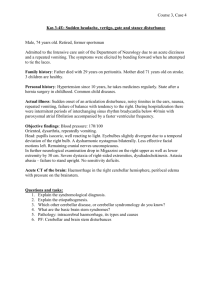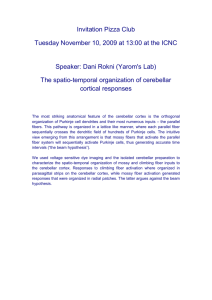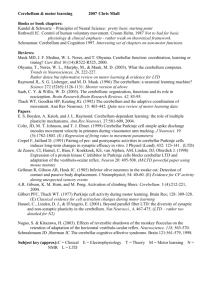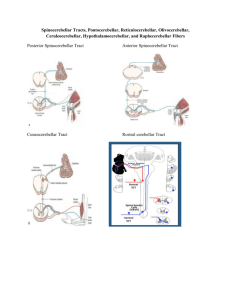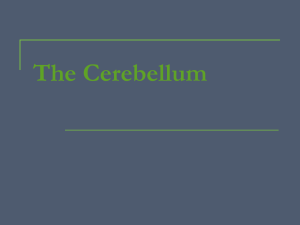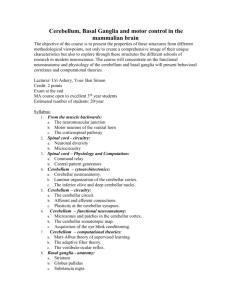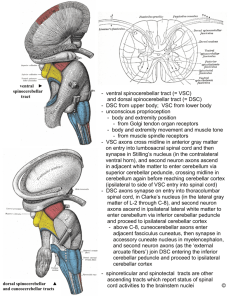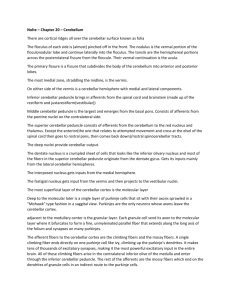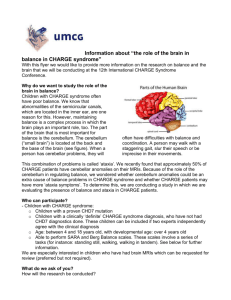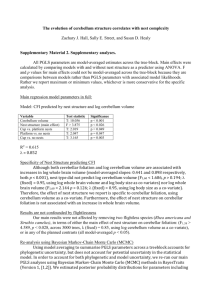The Human Cerebellum - Institute of Molecular Biosciences
advertisement
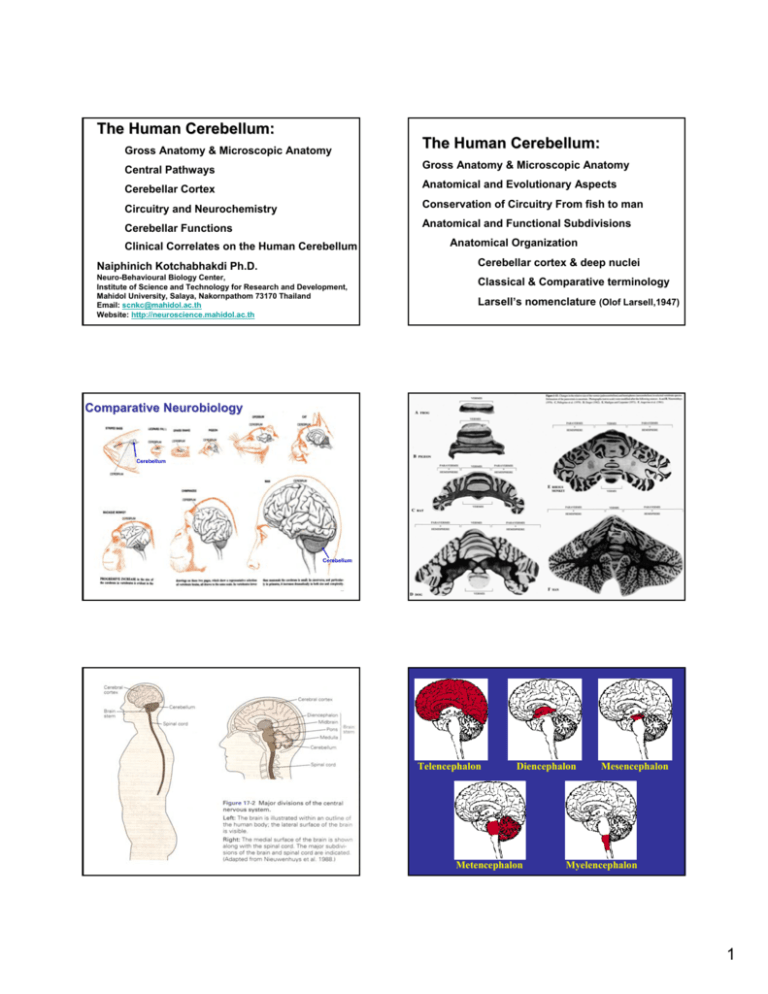
The Human Cerebellum: Gross Anatomy & Microscopic Anatomy The Human Cerebellum: Central Pathways Gross Anatomy & Microscopic Anatomy Cerebellar Cortex Anatomical and Evolutionary Aspects Circuitry and Neurochemistry Conservation of Circuitry From fish to man Cerebellar Functions Anatomical and Functional Subdivisions Clinical Correlates on the Human Cerebellum Anatomical Organization Naiphinich Kotchabhakdi Ph.D. Cerebellar cortex & deep nuclei Neuro-Behavioural Biology Center, Institute of Science and Technology for Research and Development, Mahidol University, Salaya, Nakornpathom 73170 Thailand Email: scnkc@mahidol.ac.th Website: http://neuroscience.mahidol.ac.th Classical & Comparative terminology Larsell’s nomenclature (Olof Larsell,1947) Comparative Neurobiology Cerebellum Cerebellum Telencephalon Diencephalon Metencephalon Mesencephalon Myelencephalon 1 Cerebellum Arbor vitae (tree of life) 2 The Human Cerebellum: Anatomical and Functional Subdivisions Anatomical Organization Classical & Comparative terminology Larsell’s nomenclature (Olof Larsell,1947) Functional Subdivisions Archicerebellum (Vestibulo-cerebellum) Paleocerebellum (Spino-cerebelllum) Neocerebellum (Ponto-cerebellum) The Human Cerebellum: Functional Subdivisions Archicerebellum (Vestibulo-cerebellum) Flocculo-Nodular Lobe, Lingual Lobule, Fastigial N. Equilibrium, Vestibulo-Ocular Reflex (VOR) Paleocerebellum (Spino-cerebelllum) Anterior lobe, Declive, Uvula, Paraflocculus Interpositus Nucleus (Globose & Emboliform Nuclei) Postural Control, muscle tone Neocerebellum (Ponto-cerebellum) Posterior lobe, cerebellar Hemisphere, Dentate N. Coordination of phasic movements, patterns and skilled movements 3 4 The Human Cerebellum: Cerebellar Cortex: Deep Cerebellar Nuclei: Fastigial (Medial) Nucleus Interpositus (Middle) Nucleus Globose Nucleus Emboliform Nucleus Dentate (Lateral) Nucleus 5 The Human Cerebellum: Central Pathways Cerebellar Afferent systems Cerebellar efferent systems Intracerebellar Association fibers The Human Cerebellum: The Human Cerebellum: Cerebellar Afferent systems: Extra-cerebellar Sources: Vestibular System: Primary Vestibulo-cerebellar fibers Secondary Vestibulo-cerebellar fibers Spinal Cord: Ventral spino-cerebellar tract Dorsal Spino-cerebellar tract Cuneo-cerebellar tract Spino-olivo-cerebellar tract Spino-reticulo-cerebellar tract Trigemino-cerebellar Tract Tecto-cerebellar tract Arcuato-cerebellar tract Cerebellar Afferent systems: Through brainstem relay nuclei: Vestibular Nuclei--- Secondary Vestibulo-cerebellar system Inferior Olive--- Olivo-cerebellar System (Climbing fibers) Reticular Nuclei --- Reticulo-cerebellar systems Pontine Nuclei---Ponto-cerebellar system (Mossy fibers) Perihypoglossal Nuclei---Perihypoglossal-Cerebellar system Locus ceruleus---- Norepinephrine to cerebellum Raphe Nuclei----Serotoninergic fibers to cerebellum Cranial Motor Nerve Nuclei (III, IV, V, VI, VII, IX, X, XI, XII) ? Central Cervical Nucleus. Parabracial Nucleus Nucleus of Tractus Soritarius Cerebellar peduncles Restoform Body (Inferior Cerebellar Peduncle) Brachium Pontis (Middle Cerebellar Peduncle) Brachium Conjunctivum (Superior Cerebellar Peduncle) 6 The Human Cerebellum: Cerebellar Efferent systems: Cerebellar Cortico-Nuclear Projection Systems: Flocculo-Nodular Lobe-----Vestibular Nuclei Vermis----Fastigial Nucleus Intermediate Zone ----Interpositus Nucleus Cerebellar Hemisphere ---- Dentate Nucleus Cerebellar Nuclear Efferent Systems: Fastigial Nucleus Fastgio-Vestibular System Fastigio-bulbar System Fastigio-Spinal System Uncinate Bundle of Russell Interpositus Nucleus (Globose & Emboliform) Dentate Nucleus Dentato-rubro-thalamic, Dentato-thalamic tracts to VL Nucleus of thalamus and Area #4 Motor cortex 7 8 9 The Human Cerebellum: Microscopic Anatomy Cerebellar Cortex Circuitry and Neurochemistry 10 The Human Cerebellum: Cerebellar Cortex layers: Molecular Layer Purkinje Cell Layer Granular Cell Layer (White Matter) Cell Types: Purkinje Cells ----Inhibitory (GABA) Granule Cells ----Excitatory (Glutamate) Stellate Cells ---- Inhibitory (GABA, Tuarine?) Golgi Cells ----Inhibitory (GABA, Glycine) Basket Cells---- Inhibitory (GABA) Afferent terminations: Mossy Fiber Systems----Excitatory (Glutamate, few Ach) Climbing Fiber Systems---- Excitatory (Glutamate/Aspartate) NE fibers from Locus Ceruleus Serotoninergic Fibers from Raphe Nuclei Efferent System from Cerebellar Cortex: Axon of Purkinje cells ----Inhibitory (GABA) 11 12 13 Glutamate Glutamate/ Aspartate GABA, or GABA+Glycine (Golgi cells) GLUTAMATE (few ACh) GABA ASTROCYTES ARE IMPORTANT FOR HOMEOSTATIC PROCESSES AT THE SYNAPSE: THEY ..TAKE UP GLU ..PROVIDE GLN Glutamate (few GABA) ..PROVIDE LACTATE ..TAKE UP WATER AND POTASSIUM TAURINE H2N-CH2-CH2-SO3 Noradrenalin (Locus coerelus) CBN Serotonin (Raphe) Purkinje cells Granule cells Localization of Taurine TAURINE GABA 14 15 16 CEREBELLAR PURKINJE CELL Cerebellar Circuitry ML PF 10 ms Complex Spike Cortex PL Go GC GL WM CN CF MF Inferior Olive Purkinje cell discharge 100 mV 2 ms + simple spike (SS) 30-100 hz complex spike (CS) 1.5 hz 17 The Human Cerebellum: Cerebellar Functions (Classical Functions): Co-ordination of Movements Stabilizing of Vestibulo-ocular Reflex (VOR) Patterned Skilled Movements Coordination of Eye Movements Vermis Lobule VI----Saccadic Eye Movements Flocculus---- Visual Tracking Equilibrium, Gait and Postural Controls Controls of Autonomic Functions (Cardiovascular) Immune Functions (?) 18 NAMING FACES RIGHT HAND LEFT HAND MOVING FINGERS IMAGINING MOVEMENT MEMORIZING SPATIAL LOCATIONS fMRI 19 20 The Human Cerebellum: Clinical Correlates on the Human Cerebellum: Flocculo-Nodular Lobe: Disturbed Equilibrium or Balance Tendency to fall on the side of the lesion Extensor hypotonia “Reeling or Drunken” Gait or Posture Deviation Nystagmus 1. Eye in mid-line Position: fine nystagmus, quick phase toward lesion side 2. Eye fixed 10 – 30 degree away from the lesion side: No nystagmus 3. Eye fixed beyond 30 degree away from the lesion side nystagmus with quick phase away from lesion side 4. Eye shift beyond midline toward the lesion side gross nystagnus, quick phase toward lesion side 21 The Human Cerebellum: Clinical Correlates on the Human Cerebellum: Anterior Lobe & Vermis: Hypotonia (Reduced muscle tone) Hyporeflexia Ataxia (Incoordination of Movements) Asynergia, Dysynergia (lack of synergy) Intention or Action Tremor (Atelokinesia) Asthenia (Weakness of muscular strength) Rebounded Phenomenon Cerebellar Hemisphere & Dentate Nucleus: Dysmetria (Pass pointing) Dysdiadochokinesia or Adiadochokinesia (can not perform rapid alternating movements) Disturbed Voluntary Skilled movements Disturbed Speech (Drunken Speech) 22 23 Dysmetria of thought 24
